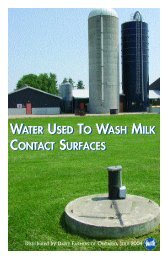Canadian Quality Milk On-Farm Food Safety Program - Centre ...
Canadian Quality Milk On-Farm Food Safety Program - Centre ...
Canadian Quality Milk On-Farm Food Safety Program - Centre ...
You also want an ePaper? Increase the reach of your titles
YUMPU automatically turns print PDFs into web optimized ePapers that Google loves.
<strong>Canadian</strong> <strong>Quality</strong> <strong>Milk</strong><br />
11.3 Troubleshooting Films and Deposits on Equipment<br />
FILM OR DEPOSIT DESCRIPTON CAUSE REMOVAL PREVENTION<br />
Mineral, calcium,<br />
magnesium<br />
• White (waterstone),<br />
chalky to<br />
gray<br />
• Improper rinsing<br />
• Dropout of minerals from<br />
water supply<br />
• No acidified rinse<br />
Iron • Brown to red • Water supply<br />
• Aggressive supply system<br />
components<br />
• No acidified rinse<br />
Inking (blacking) • Black rubber parts • Reaction between chlorine<br />
or chlorinated compound<br />
and rubber<br />
Black • Black residue<br />
deposit<br />
Protein • Blue− rainbow hue,<br />
varnish like apple<br />
sauce<br />
<strong>Milk</strong>stone or<br />
waterstone<br />
Fat/grease • Hanging water<br />
droplets with<br />
greasy (white)<br />
appearance<br />
• Oil<br />
• Rubber migration<br />
• Contact of dissimilar<br />
materials<br />
• Using non-chlorinated<br />
cleaner<br />
• Inadequate pre-rinse<br />
• Improper (sporadic or<br />
periodic) cleaning<br />
• Too hot pre-rinse<br />
• White to yellow • Mineral from milk<br />
• Mineral from water<br />
• No acidified rinse<br />
• Improper pre-rinse (cold<br />
water) temperatures<br />
• Low final temperature<br />
during cleaning cycle<br />
• Acid wash with hot water (double up<br />
on label rate)<br />
Use acid rinse regularly<br />
Make sure that alkaline product used<br />
has good water-conditioning<br />
properties<br />
Use water softener<br />
• Acid wash with hot water Use regular effective acid rinse<br />
Treat water<br />
Properly select sanitizers<br />
• Acid wash with hot water ⎯ if not<br />
removed, replace<br />
• Acid wash with hot water ⎯ if not<br />
removed, replace<br />
• Initial cleanup with equal parts of<br />
chlorine and a chlorinated alkaline<br />
detergent with hot water ⎯ double up<br />
on label usage rate<br />
• Initial cleanup with a chlorinated<br />
alkaline detergent with hot water ⎯<br />
double-up on label usage rate<br />
• Acid wash<br />
• Initial cleanup with a chlorinated<br />
alkaline detergent with hot water ⎯<br />
double up on label usage rate<br />
Use acid rinse<br />
Ensure proper dry storage<br />
Chlorine overuse<br />
Use acid rinse<br />
Ensure proper dry storage<br />
Chlorine overuse<br />
Use a chlorinated alkaline detergent<br />
Clean with appropriate dilution during<br />
each cleaning cycle<br />
Adequately pre-rinse with warm (38°<br />
to 43°C or 100° to 110°F) water<br />
Pre-rinse before milk film dries on<br />
equipment surfaces<br />
Use regular and proper cleaning<br />
procedures coupled with acid rinse<br />
Use a periodic acid wash in addition<br />
to the normal cleaning cycle<br />
Use regular and proper cleaning<br />
procedures, coupled with acidified<br />
rinse<br />
Use warm (38°C to 49°C or 100°F to<br />
11—8<br />
June 2010
















